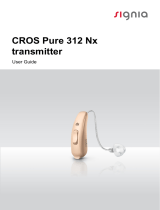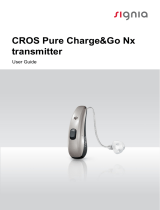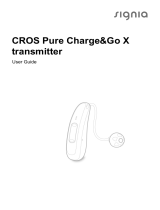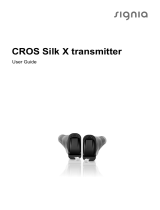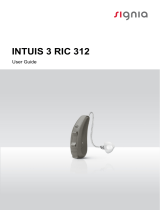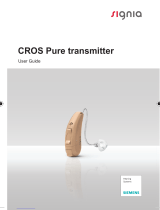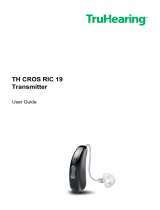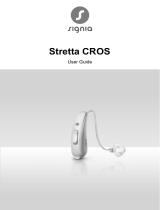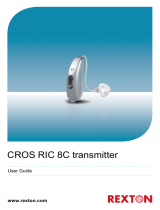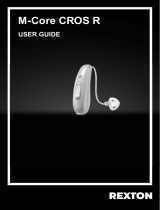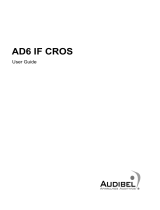Page is loading ...

CROS Pure transmitter
User Guide

2
Content
Welcome 4
Your CROS transmitter 5
Components and names 7
Controls 9
Signal tones 9
Batteries 10
Battery size and handling tips 10
Replacing batteries 11
Daily use 12
Turning on and o 12
Inserting and removing the transmitter 13
Adjuing the volume 16
Maintenance and care 17
Device 17
Ear pieces 18
Professional maintenance 20

4
Welcome
Thank you for choosing one of our hearing inrument
accessories.
This guide, along with support from your Hearing Care
Professional, will help you underand the advantages
and greater quality of life this accessory oers.
CAUTION
It is important to read this user guide thoroughly
and completely. Follow the safety information to
avoid damage or injury.

5
Your CROS transmitter
CROS solutions are designed for people with profound
hearing loss in one ear which can not be aided with a
hearing inrument. A CROS transmitter worn on this
ear captures sound from this side and transmits it to
the hearing inrument on the other ear. This allows the
wearer of the hearing inrument to hear sounds from
both sides.
CROS transmitter hearing inrument

6
Two solutions are available:
● CROS solution:
For people with normal hearing in one ear and
profound hearing loss in the other. Sounds from the
side with hearing loss are captured and transmitted
wirelessly to the good‑hearing side.
● BiCROS solution:
For people with profound hearing loss in one ear
and less severe hearing loss in the other. Sounds
from the more severe hearing loss side are captured
and transmitted wirelessly to the better‑hearing side.
The hearing inrument processes and amplies the
sounds from both sides.
The CROS transmitter works with our specic wireless
hearing inruments. Your Hearing Care Professional will
advise you on the compatible models.
NOTICE
This user guide only applies to the CROS
transmitter. Your hearing inrument has a separate
user guide.

7
Components and names
➍
➍
➎
➎
➊ Ear piece
➋ Retention receiver
➌ Receiver cable
➍ Microphone openings
➎ Rocker switch
➏ Battery compartment
(on/o switch)
➐ Side indicator
(red = right ear,
blue = left ear)
➑ Receiver connection
Ear piece, retention receiver and receiver cable are only
used to hold the device on the ear. No sound is played.

8
You can use the following andard ear pieces:
Standard ear pieces Size
Click Sleeve (vented or closed)
Click Dome™ single
(open or closed)
Click Dome semi‑open
Click Dome double
You can easily exchange the andard ear pieces. Read
more in section "Maintenance and care".
Cuom-made ear pieces
Cuom shell
Click Mold™

9
Controls
With the rocker switch you can adju the
volume.
Signal tones
Signal tones of the CROS transmitter ‑ like a low battery
beep - are sent to the hearing inrument.
Ask your Hearing Care Professional to congure the
signal tones.

10
Batteries
When the battery is low the sound becomes weaker
or you will hear an alert signal. The battery type will
determine how long you have to replace the battery.
Battery size and handling tips
Ask your Hearing Care Professional for recommended
batteries.
Battery size: 312
● The "battery low" signal of the CROS transmitter and
the "battery low" signal of the hearing inrument have
dierent melodies.
● Always use the correct battery size for your device.
● Remove the batteries if you intend not to use the
device for several days.
● Always carry spare batteries.
● Remove empty batteries immediately and follow your
local recycling rules for battery disposal.

11
Replacing batteries
Removing the battery:
XOpen the battery compartment.
XUse the magnet ick to pull out the
battery. The magnet ick is available
as an accessory.
Inserting the battery:
XIf the battery has a protective lm, remove it
only when you are ready to use the battery.
XInsert the battery with the "+" symbol
facing up (refer to the picture).
XCarefully close the battery compartment. If you feel
resiance, the battery is not inserted correctly.
Do not attempt to close the battery compartment by
force. It can be damaged.

12
Daily use
Turning on and o
XTurning on: Close the battery compartment.
The transmitter turns on after a delay of several
seconds (power-on delay).
XTurning o: Open the battery compartment.

13
Inserting and removing the transmitter
Colored markers indicate the side:
● red marker = right ear
● blue marker = left ear
Inserting:
XHold the receiver cable at the bend
closer to the ear piece.
XCarefully push the ear piece in
the ear canal ➊.
XTwi it slightly until it sits well.
Open and close your mouth to
avoid accumulation of air in the
ear canal.
XLift the device and slide it over
the top of your ear ➋.
CAUTION
Risk of injury!
XInsert the ear piece carefully and not too deeply
into the ear.

14
● It may be helpful to insert the right device with
the right hand and the left device with the left
hand.
● If you have problems inserting the ear piece,
use the other hand to gently pull your earlobe
downwards. This opens the ear canal and eases
insertion of the ear piece.
The optional retention rand helps to securely retain the
ear piece in your ear. To position the retention rand:
XBend the retention rand and position
it carefully into the bottom of the bowl
of your ear (refer to the picture).

15
Removing:
XLift the device and slide it over
the top of your ear ➊.
XIf your device is equipped
with a cuom shell or a
Click Mold, remove it by
pulling the small removal cord
toward the back of your head.
XFor all other ear pieces: Grip the receiver in the
ear canal with two ngers and pull it carefully out ➋.
Do not pull the receiver cable.
CAUTION
Risk of injury!
XIn very rare cases the ear piece could remain
in your ear when removing the device. If this
happens, have the ear piece removed by a
medical professional.
Clean and dry your device after usage. Read more in
section "Maintenance and care".

16
Adjuing the volume
XPress the rocker switch on the transmitter briey.
The volume of both transmitter and the hearing
inrument are adjued simultaneously.
Once the default, maximum or minimum volume has
been reached, you may hear an optional signal tone. Ask
your Hearing Care Professional to congure the signal
tones.

17
Maintenance and care
To prevent damage it is important that you take care of
your device and follow a few basic rules, which will soon
become a part of your daily routine.
Device
Drying and orage
XDry your device overnight.
XAsk your Hearing Care Professional for recommended
drying products.
XFor longer periods of non-use, ore your device with
open battery compartment and battery removed in a
drying syem to avoid the adverse eects of moiure.
Cleaning
Your device has a protective coating. However, if not
cleaned regularly you may damage the device or cause
personal injury.
XClean your device daily with a soft, dry tissue.
XNever use running water or immerse the
device in water.
XNever apply pressure while cleaning.
XAsk your Hearing Care Professional for recommended
cleaning products, special care sets, or more
information on how to keep your device in good
condition.

18
Ear pieces
Cleaning
Cerumen (ear wax) may accumulate on the ear pieces.
Clean the ear pieces daily.
For all types of ear pieces:
XClean the ear piece
right after removal
with a soft and dry
tissue.
This prevents that
cerumen becomes
dry and hard.
For Click Domes or Click Sleeves:
XSqueeze the tip of the ear piece.

19
Exchanging
Exchange andard ear pieces approximately every
three months. Replace them sooner if you notice
cracks or other changes. The procedure for exchanging
andard ear pieces depends on the type of ear piece.
In section "Components and names", your Hearing Care
Professional has marked your type of ear piece.
Exchanging Click Domes
XTo remove the old Click Dome, use the removal tool
or follow the inructions on the packaging of the
Click Domes. Be careful not to pull the receiver cable.
The removal tool is available as an accessory.
XTake particular care that
the new Click Dome clicks
noticeable in place.
XCheck the rm t of the new
Click Dome.

20
Exchanging Click Sleeves
XTurn the Click Sleeve inside
out.
XGrasp the Click Sleeve and
the receiver (not the receiver
cable) with your ngers and
pull the Click Sleeve o.
XTake particular care that
the new Click Sleeve clicks
noticeably in place.
Professional maintenance
Your Hearing Care Professional can perform a thorough
professional cleaning and maintenance.
Cuom-made ear pieces and wax lters should
be exchanged as needed by your Hearing Care
Professional.
Ask your Hearing Care Professional for your individual
recommendation of maintenance intervals and for
support.
/

